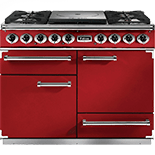
Get the right Range Cooker from Marks Electrical
At Marks Electrical we really know our stuff when it comes to range cookers. It's an expertise that comes from over three decades in the business. Not only can we show why you should choose a range cooker in the first place, but we'll also help you to choose the exact kind and size of range cooker, as well as the most suitable fuel type for your home and specific cooking requirements.
View all Range CookersWhat fuel type is best for you?

Electric
Electric range cookers are one of the most popular types for a number of reasons. For a start, a lot of people are more comfortable with electricity when compared to gas, despite gas as a whole being noticeably cheaper to run. The fact that a reliable, consistent electric supply is more common than gas in many households also helps. If you do decide to choose an electric range cooker then there are two types of hob to consider.
Ceramic - Contemporary feel & stylish. Easy to wipe clean.
Induction - Engery efficient. Safe to touch. Quick to heat up & stylish.
Shop Ceramic Shop Induction
Gas
Gas range cookers are incredibly versatile. As well as offering an unbeatable balance between precise control and practicality, most gas-fuelled range cookers come with flame failure safety measures, completely eradicating the risk of using a natural fuel such as gas. Using gas can also be cheaper to run in the long-term, when compared with its other fuel counterparts. Gas range cookers give you everything you need to make beautiful cuisine. Open up a world of authentically-cooked, exotic foreign dishes, or take full advantage of the extra workspace, oven cavities and precise hob burners so you can create an English roast dinner that's truly fit for a king.
Shop Gas
Dual Fuel
The dual fuel option offers plenty of benefits for serious cooks. If you're lucky enough to have easy access to both an electric and gas supply in your kitchen then dual fuel range cookers have to be a consideration for you. In fact, professionals love the versatility of having two fuel types - responsive gas hobs and fan-assisted electric ovens are a formidable force in terms of thorough cooking power. With a dual fuel range cooker you get all the benefits of each fuel type, which helps counteract the disadvantages each one may have. At Marks Electrical, we have an unbeatable level of experience selling a huge variety of dual fuel range cookers. There's plenty to choose from.
Choosing the right size of range cooker:
We have range cookers available in a variety of different sizes:
The great thing about range cookers is they've come a long way from the large one size models of yesteryear. We have range cookers available in a variety of different widths: 70, 90, 100, 110 and even 120+cm. Smaller range cookers will fit into less spacious kitchens, while wider ones will provide better oven and hob capacity for those larger, elaborate meals. When considering what size you want for your preferences and available space, it's also worth remembering that the range cooker makers advise a 5mm 'recess dimension' to provide important ventilation for the cooker.
Considering your oven type

Multifuctional Ovens
If a range cooker has a multifunctional oven then it's equipped to handle a variety of purposes in one - making life far easier when it comes to getting the right results with your cooking. A multifunctional oven essentially takes a conventional oven and a fan oven and combines them. This makes a multifunctional oven an impressive 'all rounder' of the oven world - roasting, baking, grilling and browning to a very high standard.

Conventional Ovens
On a conventional oven, the heating elements are normally located lower down in the oven cavity and, because hot air rises, they give clearly defined areas of temperature in the oven cavity. This is where conventional ovens really come into their own because the top is hottest, while the lower parts of the oven will be slightly cooler in comparison. This is excellent for baking as it allows you to cook at different temperatures at the same time.

Fan Ovens
There are many benefits of a fan oven - cooking times can be quicker, while pre-heating is more swift. Additionally, thanks to the presence of the fan, you'll find a consistent temperature regardless of where you place your food and on what shelf. This is because the fan evenly circulates heat around the interior of the oven, resulting in a regular temperature throughout.

Fan Assisted Ovens
Similar to an out-and-out fan oven in concept, fan-assisted ovens have heating elements at the top AND the bottom of the oven cavity for more even heating. You'll find the temperature is slightly higher in the top than the bottom with a fan-assisted oven. This means you can easily 'brown off' items of food such as pies or meats.
Cleaning - keeping your range cooker as good as new

Enamel Liners
Enamel liners are the most common feature for helping you keep your cooking appliances clean. Bits of food and grease cannot get into the liner as easily because of the small bumps in the enamel being closer together. Due to the price, most range cookers will tend to come with the other two options - catalytic or pyrolytic liners.

Catalytic Liners
Catalytic liners really help take away the labour intensive nature of cleaning ovens. Essentially, catalytic liners absorb the grease along with dirt and grime particles that build-up in the oven. They are then burnt off, or 'oxidised', at temperatures of around 200°C. Catalytic liners have a remarkable lifespan but when they do need replacing, it is a simple job to put new ones in.

Pyrolytic Liners
Range cookers that have pyrolytic liners in the oven cavities have the most thorough way to 'self clean'. At the press of a button you can set a range cooker to initiate a clean, taking the temperature of the ovens up to a hefty 500°C, oxidising pretty much anything dirt and grease-related into ash. This can be swept out of the oven once the process has finished.



 You've added an item to your basket.
You've added an item to your basket.